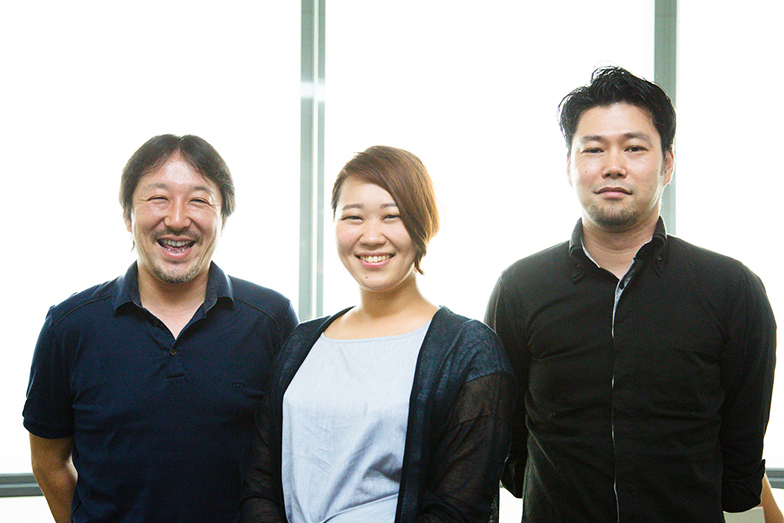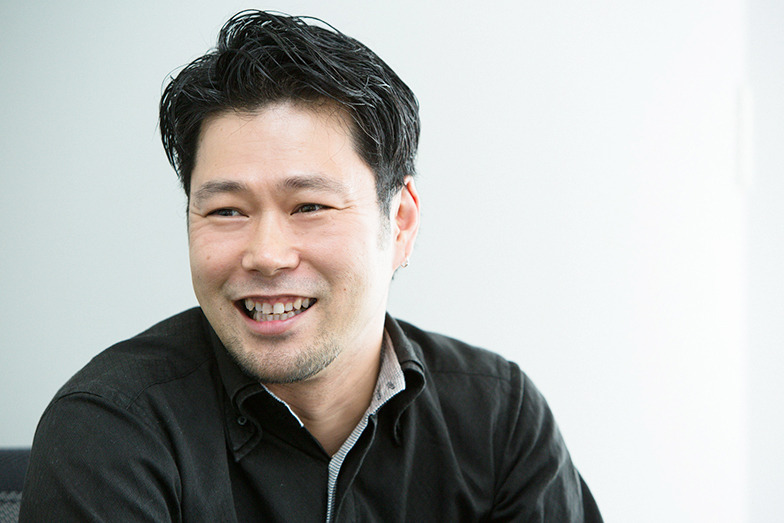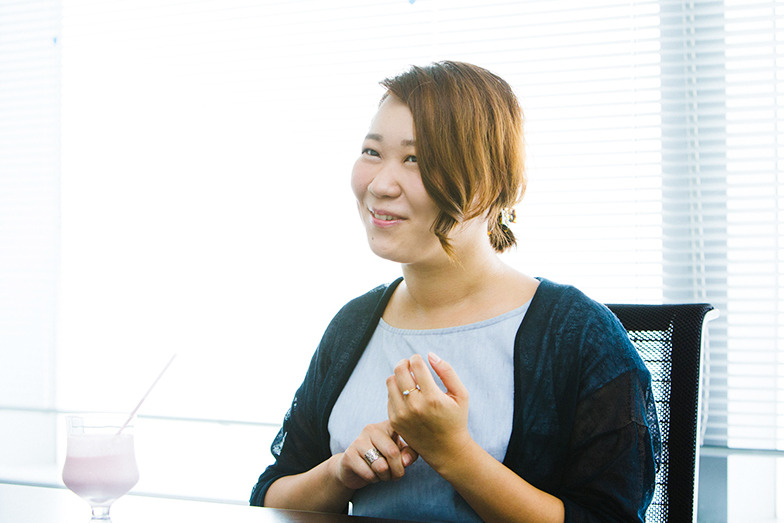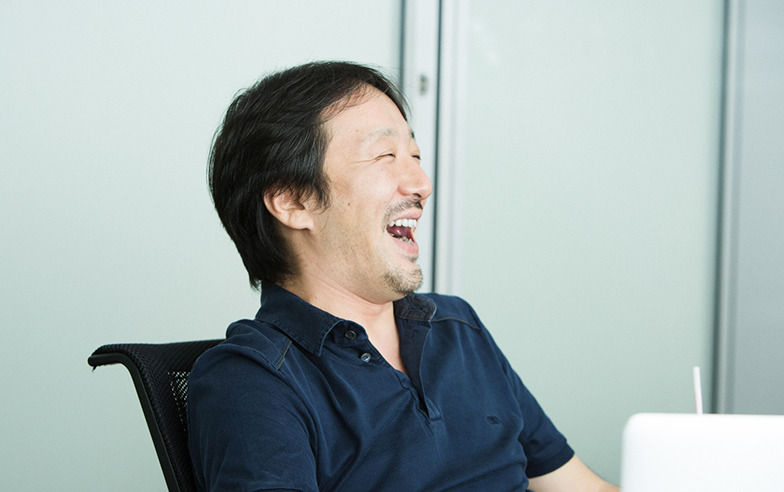Considering the future of "Illumination"
The " SUMMER LIGHT GARDEN " at Tokyo Midtown, held until the end of August.
Masahiro Watanabe of Komaden, Naoko Amada of Dentsu Tech, and Kazuaki Harada of Dentsu Inc., who produced the entertainment show featuring illuminations depicting a clear stream and "light fireworks," discussed the planning, technology, and future of illumination events.
Interview, Editing, Composition: Aki Kanahara, Dentsu Inc. Event & Space Design Bureau

What exactly is the definition of "illumination"?
Harada: What kind of illumination do you think is popular in Japan right now?
Amada: I feel like projection mapping is definitely the thing right now. But is projection mapping illumination? I think that's also up for debate.
Harada: I don't think projection mapping is illumination. It combines different performance elements and technologies to create a single show. In the sense of using light in a dark space to express some form of entertainment, illumination and projection mapping are similar, but the technologies are completely different.
Watanabe: Illumination generally follows two main approaches: designs centered around a main motif, and designs that scatter elements throughout an entire area. With technological advances, I feel like we're seeing more illumination displays that incorporate movement within a set timeframe lately. I suspect the definition of illumination presented in popular magazines and such is simply calling "things that glow" illumination.
Harada: I see. So, what the general public refers to as illumination is something that expresses something through light in a dark space?
Watanabe: Video installations have a fixed viewing direction. You can't see the monitor from behind it. Illuminations, however, can be seen from various angles. Also, video is composed of flat surfaces.
Harada: Right. I think that's quite important. Video is about planes, isn't it? Illumination, on the other hand, uses points to form shapes and create three-dimensional objects. The biggest difference between video and illumination, I think, is whether you're transmitting information within a fixed form, or designing light within a space to express something entirely different.
Watanabe: I believe design in products or architecture inherently involves functional beauty. Illumination doesn't need functional beauty; it leans more towards entertainment, designed to delight the viewer. Unlike conventional design, it's specialized in making people go "Wow!" when they see it.
When I design, if I stick too rigidly to set forms, it ends up looking like environmental lighting fixtures. To achieve illumination, I base it on extremely small point light sources. If the light source surface is large, it loses the illumination feel. When it's dotted, people perceive it as illumination.

Amada: That might be true.
Watanabe: I don't think anyone would be enchanted by a star shape made from a flat surface, but when the same shape is formed by tiny point light sources, people say it's "beautiful," right?
Amada: True. If fireflies were big, it would be a bit off-putting, right? (laughs) Small lights might be key.
Harada: There seem to be various theories about the origin of illumination, but it apparently started in Europe as an attempt to express stars with light.
Watanabe: I think the origin of illumination is probably connected to Christmas. Back then, of course, filament light bulbs didn't exist. For Christmas celebrations, lots of candle flames would decorate altars or something, and people thought, "Ah, this is pretty. Let's try decorating over there with candles too." That's probably how it started.
So, while stars fit that description, I think the true roots of illumination lie in candles or fire. If it's fire, that slight change in light – that flickering, movement – is still widely accepted and appreciated today.
Harada: I see. There's this deep-seated psychological connection to fire—a sense of calm, longing, beauty—and it's precisely because of that we feel a kinship with illuminations that move, flicker, and sparkle.
Watanabe: I think that's exactly it.
Harada: I see, so that's the Watanabe theory (laughs).
Amada: Definitely, warm-toned illuminations give that feeling. Blue illuminations feel more fitting for stars, though.

The shift from filament to LED dramatically expanded expressive possibilities.
Harada: Since we're talking about light colors, let's discuss LEDs.
Watanabe: The original illumination was filament light bulbs. Illumination spread because blue light-emitting diodes were developed. Light-emitting diodes existed before I was born and were used extensively in bus electronic display boards and pilot lamps, but they could only produce light between the primary colors of red and green, so their expression was inevitably limited.
With the advent of blue, it became possible to express the three primary colors of light, RGB, making it possible to shine in any color.
Harada: Please list some things that have become possible with LEDs.
Watanabe: The biggest difference I feel between the filament era and LEDs is that filament light is amber-based. Since the original filament color is amber, it couldn't produce a true blue. It inevitably turned out light blue. Because it was amber + blue, it was quite difficult to produce a beautiful white.
Harada: In that sense, color reproduction has become significantly more accurate.
Watanabe: Yes. We can now produce cool colors. People often say LED light feels cold, but I believe it has expanded the range of expression.
Amada: Now it's about 17 million colors, right?
Watanabe: That's right. The number of light gradations we can produce. Well, I don't know if anyone has actually verified whether we can produce every single one of those colors.
Harada: Theoretically, yes. In that sense, the invention and widespread adoption of blue LEDs was a major revolution for the illumination industry.
Watanabe: And then there's the heat issue, of course. With filaments, heat is inevitably generated at the same time, which damages wood and, if the light accumulates, can become hot enough to cause a fire hazard. Switching to LEDs solved the heat problem, eliminated electrical capacity issues, and made decoration much easier.
Designing the illumination and programming the control systems
Harada: Beyond the evolution to LEDs, there's also the programming and control aspect—how to express specific colors in specific ways. Does that mean control technology has also advanced significantly?
Watanabe: This might get a bit technical, but about 20 years ago, when creating movement in light displays, our company basically used six channels in sequence. That was considered "movement."
The introduction of digital signals dramatically increased the number of channels we could handle. For example, DMX signals are now the mainstream format; essentially, two signal wires can control 512 channels. So, I think digitization has been the biggest driver of progress in control systems.
Harada: The level of detail you can express, the diversity of expression, exploded.
Watanabe: To use the earlier analogy, it's like having 100 light bulbs. Before, we'd basically run the lighting decorations using a repeating 6-channel pattern. Now, we can use all 100 bulbs to create a wave effect across the entire display, or use them all to create a gradient, wave-like expression.
Harada: How many people in Japan can handle everything from illumination design to the actual control systems?
Watanabe: Probably very few. While being able to do both simultaneously is an advantage, creating the motion effects yourself is extremely demanding and time-consuming.
Harada: So, aside from you, Watanabe-san, there's virtually no one else who can handle illumination design and programming end-to-end?
Watanabe: There are probably people who supervise, but I think few actually produce it themselves.
Harada: If moving illuminations become mainstream, won't it become tough for people who've only done illumination design up until now?
Watanabe: No, I actually think animated illuminations have their weaknesses too. Take Midtown, for example. Various content lights up and fades out, creating a show with a clear beginning, development, turning point, and conclusion. That means most of the time, not all lights are on.
They're meant to be decorative, yet they're fully lit for such a short time. So even though a lot of money is spent decorating, it ends up looking dim. Sometimes, leaving everything lit constantly actually looks more spectacular.
Harada: When Watanabe-san mentions movement, he's referring to flashing—lights turning on and off. But I think the transformation of light colors is also a form of movement.
Watanabe: Ah, I see. Like from red to blue, right?
Harada: So in that sense, Watanabe-san, you're saying you make the whole thing appear to move by controlling the lights turning off and on in a multifaceted way. You handle the design and program the control, including that movement. Doing that all in one place is my strength.
Watanabe: Well, yeah (laughs). Since I'm a company employee, it's "our company's strength," right?

"Illumination" is becoming a "technique"
Watanabe: Japan's current illumination scene has become a bit of a Galapagos phenomenon, hasn't it?
Originally, it was expressed as entertainment, like in Las Vegas. But no other country besides Japan has narrowed the target audience—like couples or families—and diversified the expressions to meet those specific needs.
Amada: They do it for every season too, right? Like cherry blossom illuminations or bamboo illuminations.
Harada: They're delicate, incredibly meticulously crafted. The final product is like wabi-sabi art. Asia seeks flashiness, right? Europe seems to seek sacredness.
Watanabe: In Japan, illuminations themselves have increasingly become the main attraction. Las Vegas uses high-tech displays, but they aren't illumination shows. Japan focuses solely on the illuminations themselves to draw crowds.
Amada: Media artists have started getting involved in illumination, right? Following that trend, maybe it could lead to a movement away from isolationism.
Harada: People specializing in other fields are now trying to use expressions like illumination. Maybe we could see this as the exit expanding.
Amada: The outlets are definitely expanding. Whether we're seeing more Galapagos-like niches (laughs) or moving toward globalization, I think it's still unclear.
Watanabe: I think what people coming to see illuminations are seeking is probably something unreal.
So, when considering how to express something more detached from the concept of everyday life—something extraordinary—it naturally becomes easier to express by combining various elements. I can't help but feel the day when illumination artisans lose their place might be approaching.
Harada: There are so many challenges. We've talked about illuminations for an hour and a half today, and I feel like we could still go on. It's really deep.
Was this article helpful?
Newsletter registration is here
We select and publish important news every day
For inquiries about this article
Back Numbers
Author

Masahiro Watanabe
Komaden Co., Ltd.
With a signature approach of integrated design from form to presentation, the company has handled numerous illumination projects for commercial facilities and theme parks both domestically and internationally.

Naoko Amada
Dentsu Tech Inc.
We handle integrated promotions that blend the physical and digital realms, primarily within the real estate industry, including town planning and commercial facility branding. In winter, we travel across the country to inspect illumination displays.
Articles by this person

Kazuaki Harada
Dentsu Inc.
Event and space planner/producer specializing in communication rooted in real-world experiences. Handles numerous domestic and international projects including expositions, major sporting events, showrooms, and exhibitions.